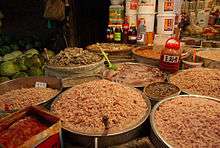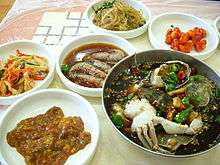Jeotgal
| Jeotgal | |
 Saeujeot in the front and various jeotgal being sold at Gyeongdong Market, Seoul. | |
| Korean name | |
|---|---|
| Hangul | 젓갈 or 젓 |
| Hanja | n/a |
| Revised Romanization | Jeotgal or Jeot |
| McCune–Reischauer | Chŏtkal or Chŏt |
 |
| This article is part of a series on |
| Korean cuisine 한국 요리 조선 료리 |
|---|
|
Staples |
|
|
Jeotgal or jeot (Korean pronunciation: [tɕʌtkal]) is a salted fermented food in Korean cuisine. It is made with various seafood, such as shrimp, oysters, shellfish, fish, fish eggs, and fish intestines.[1]
Jeotgal is mainly used as a condiment in pickling kimchi and as a dipping sauce for pig's feet (jokbal) and blood/noodle sausage (sundae). Sometimes, jeotgal, commonly saeujeot, is added to Korean-style stews (jjigae) and soups (guk and tang), for flavor instead of using salt or soy sauce (ganjang).
The types of jeotgal vary depending on main ingredients, regions, and family and personal preferences. In past times, due to the limited transportation, regions near seas had more types of jeot compared to the inland areas.
History
The Erya (爾雅), a Chinese dictionary written in the third-fifth centuries BC, contains a record about ji (鮨), the origin of jeotgal. Ji indicates jeotgal, food made with fish and is the oldest document mentioning this food in the historical records.
Types
- Saeujeot - jeot made with small shrimp (saeu, 새우)[1]
- Ojeot (오젓) - saeujeot made with shrimp harvested in May
- Yukjeot (육젓) - saeujeot made with shrimp harvested in June
- Tohajeot (토하젓) - jeot made with small freshwater shrimp,[2] which is rare local specialty of Jeolla Province
- Hwangsaegijeot (황새기젓) - jeot made with fish[1]
- Myeolchijeot - jeot made with anchovies (myeolchi, 멸치)[1]
- Jogijeot - jeot made with croaker (jogi, 조기)[3]
- Jogaejeot (조개젓) - jeot made with shellfish[4]
- Guljeot (굴젓) - jeot made with oyster (gul, 굴)
- Eoriguljeot (어리굴젓) - jeot made with salted oysters and hot peppers[1]
- Myeongran jeot (명란젓) - jeot made with roe (ran, 란) of pollock (myeongtae, 명태)[1]
- Changnanjeot (창란젓) - jeot made with pollock intestines[1]
- Ojingeojeot (오징어젓) - jeot made with squid (ojingeo, 오징어)[1]
- Ggolddugijeot (꼴뚜기젓) - jeot made with small squid[5]
- Gejang - jeot made with crabs[1]
Gallery
 Gejang and saeujang (shrimp marinated in soy sauce)
Gejang and saeujang (shrimp marinated in soy sauce) Myeongran jeot
Myeongran jeot
 Ojingeo jeot
Ojingeo jeot
References
- 1 2 3 4 5 6 7 8 9 "Jeotgal". Korea Tourism Organisation. Archived from the original on 2004-04-23.
- ↑ "Gangjin Celadon Festival 2012; The Melting Pot of Past, Present and Future". Korea Tourism Organisation. Retrieved 2013-04-02.
- ↑ "The Ingredients for Kimchi and Their Characteristics". Salted and fermented fish (Jeotgal). The Korean Culture and Information Service Center (KOIS). Archived from the original on 2008-03-28. Retrieved 2008-05-06.
- ↑ "Jeot". Korean Cultural Center Los Angeles. Archived from the original on 2006-11-01. Retrieved 2013-04-02.
- ↑ "꼴뚜기젓". Naver Dictionary. Retrieved 2013-04-02.
External links
| Wikimedia Commons has media related to Jeotgal. |
- (Korean) General information and history of Jeotgal
- (Korean) Information about Jeotgal
- (Korean) General information and history of Jeotgal
 |
| This article is part of a series on |
| Korean cuisine 한국 요리 조선 료리 |
|---|
|
Staples |
|
|